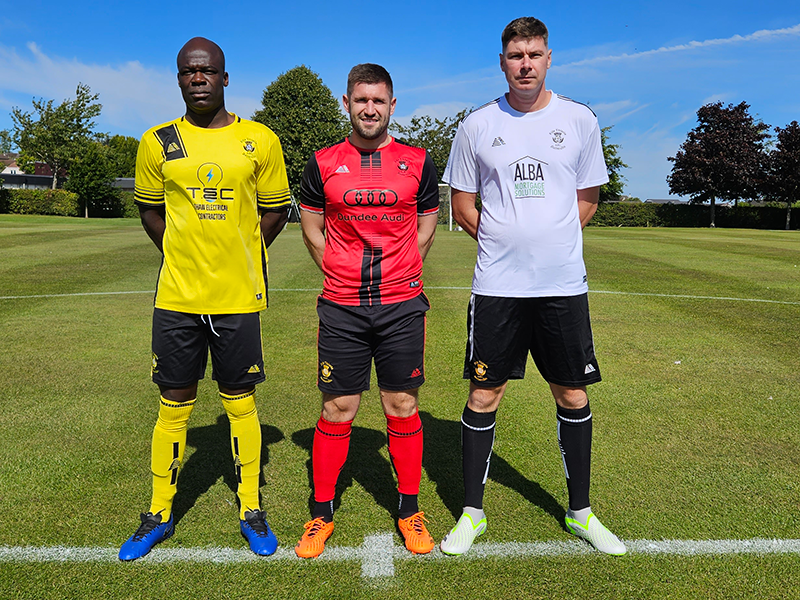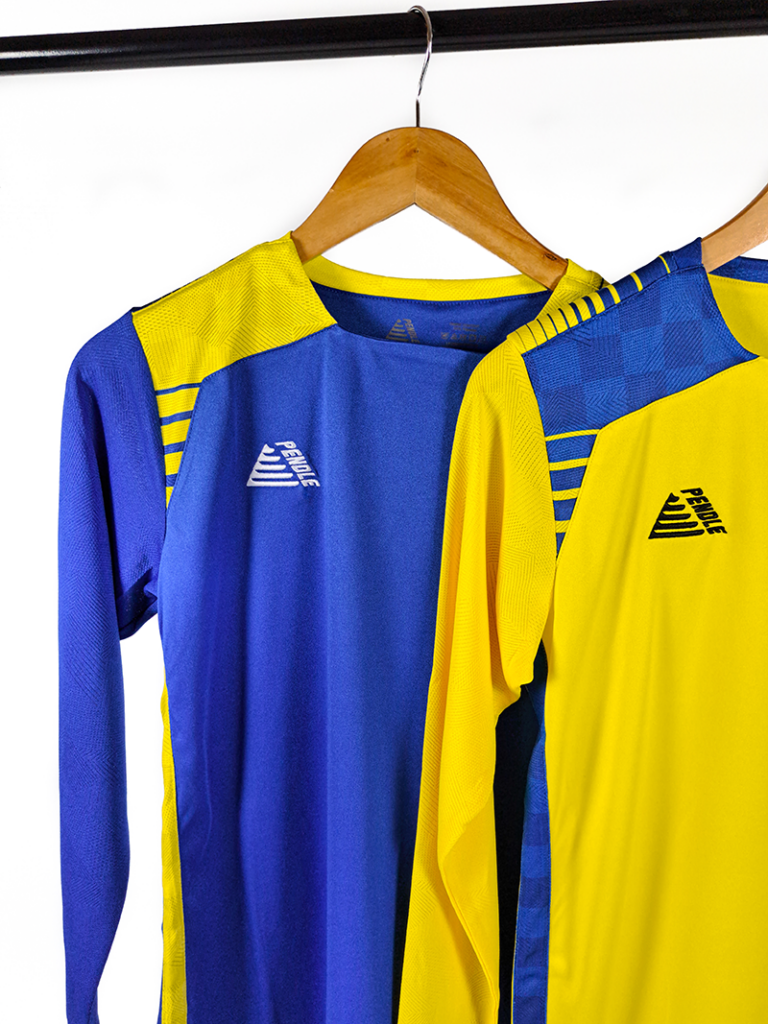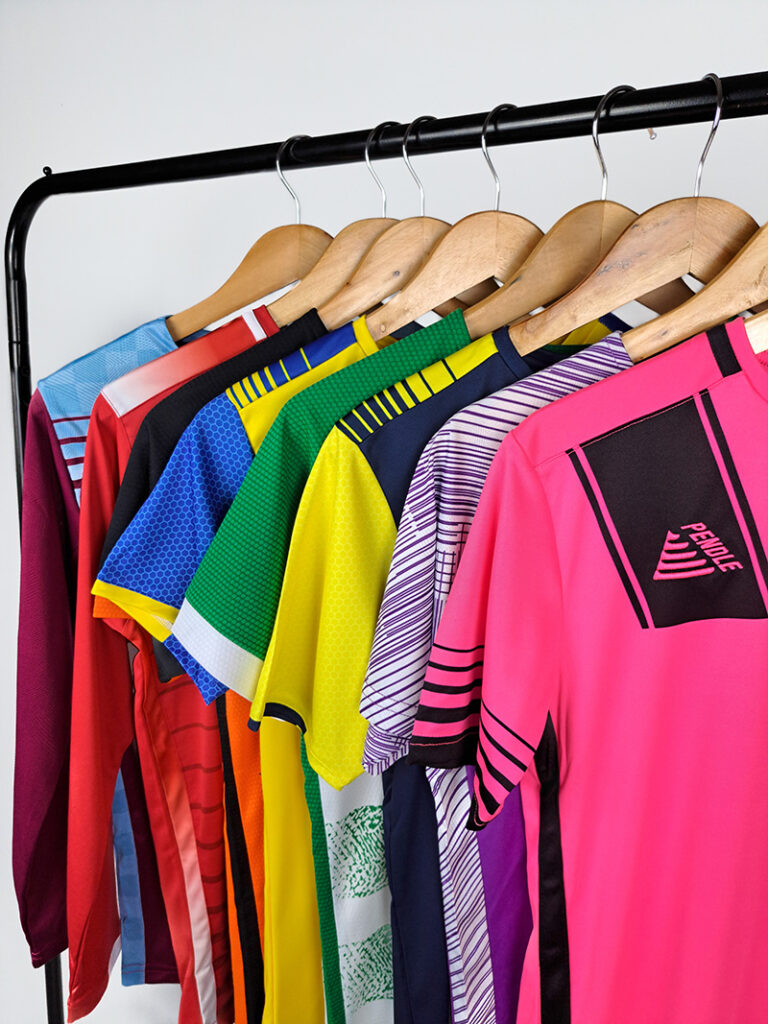Last Updated on: 25th June 2025, 11:35 am
A Complete Guide to Third Kits in Football
What is the third football kit used for?
Ever turned up on matchday to find both teams are wearing almost identical football kits? That’s where a third kit comes in. But how likely is it that you’ll actually need one? In this complete guide, we’ll break down what they are, why professional teams use them, and whether your team needs to add one to its kit lineup.

Fife Thistle AFC – 2023
What Is a Third Football Kit?
A third football kit is an alternative strip that teams wear when both their home and away kits clash with their opponent’s colours. It’s essentially a backup to the backup.
While third kits were once rare, they’ve become standard in professional football. Clubs often use them in leagues and tournaments with diverse opponents, and also as a way to introduce fresh designs each season. Typically, they feature more creative, unconventional colour schemes that stand out from the traditional home and away options.
Why Do Professional Teams Use Third Kits?
- Colour Clashes: Some matchups result in both teams’ home and away kits looking too similar. They ensure a distinct option is always available.
- Regulations: Tournaments like the FA Cup or UEFA competitions have strict kit rules. They help teams stay compliant.
- Marketing & Merchandise: For top clubs, they’re a commercial opportunity. Unique designs can boost shirt sales and fan engagement.
- Creative Freedom: Unlike home kits, which are often tied to tradition, they allow designers to experiment with colours, materials, and styles.
Official Rules
The FA has strict rules concerning clashing colours that teams have to follow.
- The two teams must wear colours that distinguish them from each other and the match officials
- Each goalkeeper must wear colours that are distinguishable from the other players and the match officials
- If the two goalkeeper kits are the same colour and neither has another shirt, the referee allows the match to be played.

These rules also have a priority, which favours the home team first. This means the home team should always be wearing their home kit, and it is up to the visiting team to find an option that doesn’t clash. So, if you’re playing away, you’ll need to ensure that you have a kit option that is distinct from the home team.
Why kit clashes matter
Avoiding kit clashes isn’t just about following the rules. They have a greater impact on a player’s performance. A study from York University showed that any kit colour clash (either in shirt or shorts) means a player takes twice as long to find a teammate on the pitch.
The experiment shows that players were slower to find fellow players on the field when teams played in crossed kits. This is bad news if you’re playing in white shirts with red shorts and your opponents are playing in red shirts with white shorts.
The study also revealed that there was significant confusion for players when both teams were wearing the same colour shorts. Their response times were quicker when there was no overlap in short colour. So, it’s definitely within your interests to have a kit that doesn’t clash with your opponents.
Do Amateur Clubs Need a Third Kit?
Short Answer: No, but it can be useful.
Amateur clubs usually have tighter budgets and fewer fixtures. Whether you need one depends on your league, matchday experiences, and opponents.
Situations Where It Helps:
- Frequent colour clashes in your league
- Participation in regional or national tournaments
- Shared club colours among local teams
They can help provide flexibility and avoid awkward matchday kit issues. However, this won’t always be an issue, and most clubs won’t need this addition. If you don’t experience frequent kit clashes, then it’s likely your home and away kits will be sufficient.

Pros and Cons of Having a Third Kit
Pros
- Avoids last-minute kit clashes
- Adds a professional look to your team
- You can experiment with bold designs
- Can double as a training or warm-up kit
Cons
- Additional cost for clubs on a budget
- May only be used a few times per season
- Extra kit to store, wash, and manage
When Should Your Club Get One?
You might want to consider investing in a third kit if:
- You’ve had to borrow kits or switch shirts on matchday
- You compete in multiple competitions with unfamiliar opponents
- Your home and away kits are similar in tone (e.g. both dark)
- You want a unique look for cup finals, tours, or promotional events
Having one can offer peace of mind and polish your club’s image. It will all depend on the individual club and who they’re facing. It’s certainly not a must for everyone, as you’ll probably find that your home and away kits prevent any clashes. There are also other ways that you can prepare for any unexpected clashes. Maybe consider having a backup colour for shorts and socks? This might be all that is needed to make things clearer on the pitch.
How to Choose Your Kit
Designing a third kit gives you more creative freedom than your home or away strips. You’ll also want to make sure that the colourway is unique so you can be sure to avoid any clashes. The rules about what counts as a clash aren’t particularly clear and create some inconsistencies. It’s not just about shirts; your shorts and socks need to be distinct from the other team to ensure match officials can assess gameplay and make fair calls.
Tips:
- Choose a unique colour palette: Avoid overlap with home and away kits.
- Prioritise contrast: Ensure visibility against your most common opponents.
- Be bold: Go for experimental colours and patterns.
- Use Our Kit Builder: Pendle’s online kit builder helps you visualise your new kit.
Final Thoughts
Third kits may have started as a trend for professional clubs, but they’re increasingly relevant at all levels. It can be a smart investment, whether you’re looking to avoid colour clashes, strengthen your club’s identity, or add a touch of flair.
At Pendle Sportswear, we offer a wide range of football kits in various designs and colourways. If you’re looking for a shirt that will stand out, browse our eye-catching colour combinations. You can also be sure that you’ll get the best deal for your club. Take advantage of our kit deals to get full team kits for less.
Tags: Football advice, football kit, football kit design, Football Kits, third kits, tips for buying football kits

